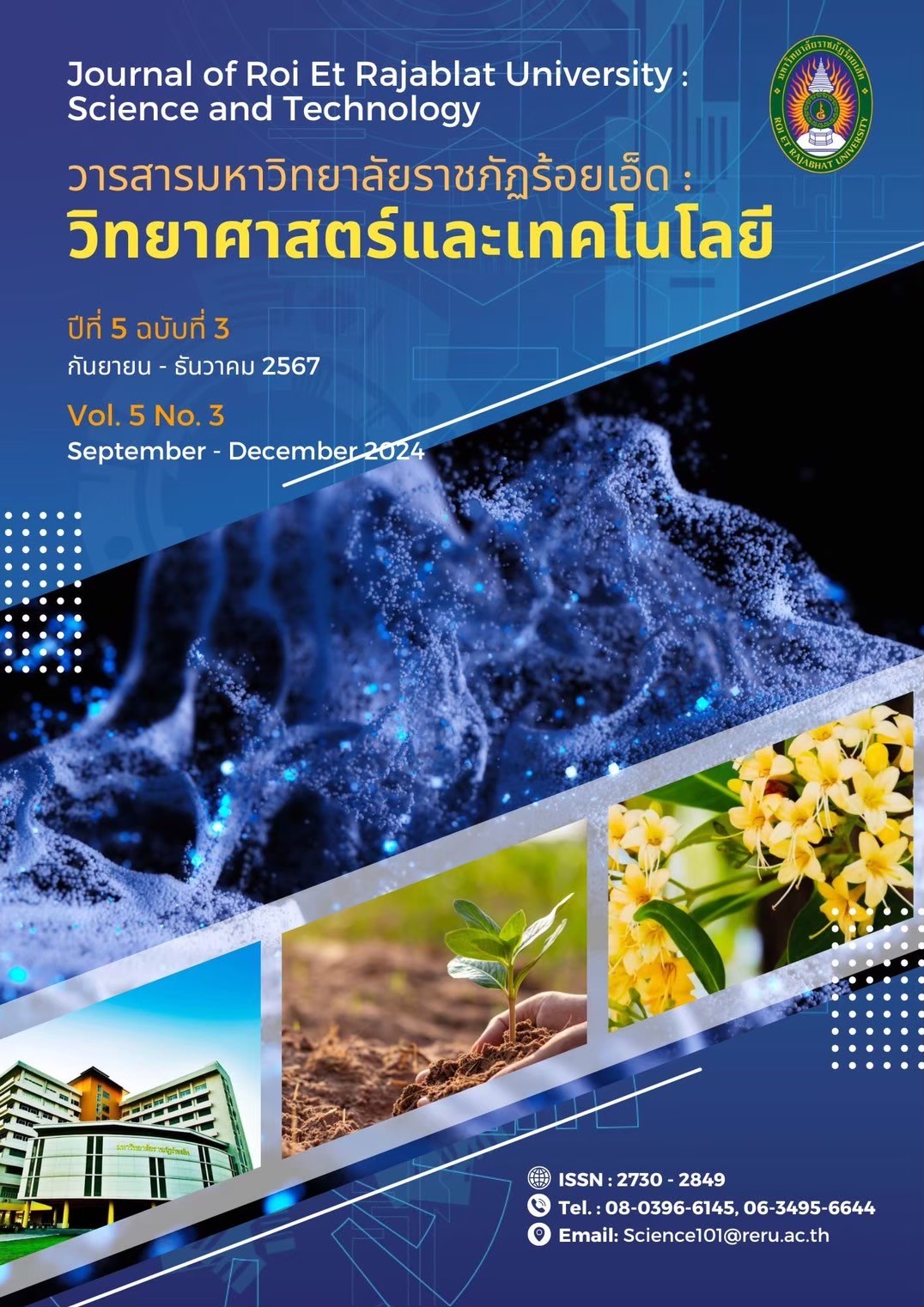ประสิทธิภาพของสารกลุ่มฟลาโวนอยด์จากต้นสักขีต่อการต้านเชื้อ Escherichia coli TISTR 527
คำสำคัญ:
สักขี, กิจกรรมต้านแบคทีเรีย, ฟลาโวนอยด์, Escherichia coliบทคัดย่อ
การแยกสารสำคัญจากส่วนสกัดหยาบเมทานอลของลำต้นสักขี ด้วยเทคนิคทางโครมาโทกราฟี ได้สารกลุ่มฟลาโวนอยด์ที่มีการรายงานโครงสร้างแล้ว จำนวน 4 สาร ได้แก่ pinocembrin (I), naringenin (II), biochanin A (III), และ sativanone (IV) และวิเคราะห์โครงสร้างทางเคมีของสารทั้งหมดด้วยเทคนิคทางสเปกโทรสโกปี IR, 1H และ 13C NMR นำสารบริสุทธิ์ทั้งหมดที่แยกได้มาศึกษาฤทธิ์การต้านเชื้อแบคทีเรียต่อเชื้อ Escherichia coli TISTR 527 ด้วย broth dilution assay และหาค่าความเข้มข้นต่ำสุดที่มีฤทธิ์ยับยั้งเชื้อ (MIC) และฆ่าเชื้อ (MBC) ผลการศึกษาพบว่า pinocembrin (I) สามารถต้านเชื้อได้ดีที่สุด มีค่า MIC และ MBC เท่ากับ 17.19 และ 137.5 µg/mL ตามลำดับ
References
Boongapim, R., Ponyaim, D., Phiwthong, T., & Rattanasuk, S. (2021). In vitro antibacterial activity of Polyalthia debilis (Pierre) Finet & Gagnep Extracts against Klebsiella pneumoniae TISTR 1383. Journal of Science and Technology, Rajabhat Maha Sarakham University, 5(2), 1-9. https://doi.org/10.1055/s-2006-957394
Chan, S. C., Chang, Y. S., Wang, J. P., Chen, S. C., & Kuo, S. C. (1998). Three new flavonoids and antiallergic, anti-inflammatory constituents from the heartwood of Dalbergia paviflora. Planta Medica, 64(2), 153-158. https://doi.org/10.1055/s-2006-957394
Choi, S. Y., Ha, T. Y., Ahn, J. Y., Kim, S. R., Kang, K. S., Hwang, I. K., & Kim S. (2008). Estrogenic activities of isoflavones and flavones and their structure-activity relationships. Planta Medica, 74(1), 25-32. https://doi.org/10.1055/s-2007-993760
El-Mahdy, M. A., Zhu, Q., Wang, Q. E., Wani, G., Patnaik, S., Zhao, Q., Arafa, S., Barakat, B., Mir, S. N., & Wani, A. A. (2008). Naringenin protects HaCaT human keratinocytes against UVB-induced apoptosis and enhances the removal of cyclobutane pyrimidine dimers from the genome. Journal of Photochemistry and Photobiology, 84(2), 307-316. https://doi.org/10.1111/j.1751-1097.2007.00255.x
Gao, M., Liu, R., Zhu, S. Y., & Du, G. H. (2019). Pinocembrin Protects from AGE-Induced Cytotoxicity and Inhibits Non-Enzymatic Glycation in Human Insulin. Cells, 8(5), 385. https://doi.org/10.3390/cells8050385
Hirai, S., Kim, Y. I., Goto, T., Kang, M. S., Yoshimura M., Obata, A., Yu, R., & Kawada, T. (2007). Inhibitory effect of naringenin chalcone on inflammatory changes in the interaction between adipocytes and macrophages. Life Sciences, 81(16), 1272-1279. https://doi.org/10.1016/j.lfs.2007.09.001
Liu, R. X., Li, L., Wang, Q., Wang, W., Bi, K.S., & Guo, D. A. (2005). Simultaneous determination of nine flavonoids in Dalbergia odorifera by LC. Chromatographia, 61, 409-413. https://link.springer.com/article/10.1365/s10337-005-0520-0
Meesup, P., & Buachard, S. (2018). Efficiency of plant extracts against Staphylococcus aureus and Escherichia coli. Agricultural Science Journal, 49(2), 485-488. https://research.kpru.ac.th/research2/pages/filere/2132019-09-05.pdf
Pichiansunthorn, C., Chavalit, M., & Jeerawong, V. (1999). Text Book of Medicinal Plants. Bangkok: Amarin Printing and Publishing.
Promden, W., Monthakantirat, O., Umehara, K., Noguchi, H., & De-Eknamkul, W. (2014). Structure and Antioxidant Activity Relationships of Isoflavonoids from Dalbergia parviflora. Molecules, 19(2), 2226-2237. https://doi.org/10.3390/molecules19022226
Rattanasuk, S., and Phiwthong, T. (2021). A new potential source of anti-pathogenic bacterial sunstances from Zamioculcas zamiifolia (Lodd.) Engl. Extracts. Pakistan Journal of Biological Sciences, 24(2), 235-240. https://doi.org/10.3923/pjbs.2021.235.240
Smitinand, T. (1983). Valuable Economic Plants in Thailand Part III. The Forest Herbarium. Bangkok, Thailand: Royal Forest Department.
Songsiang, U., Hahnvajanawong, C., & Yenjai, C. (2011). Cytotoxicity of chemical
constituents from the stems of Dalbergia parviflora. Fitoterapia, 82, 1169-1174.
https://doi.org/10.1016/j.fitote.2011.07.015
Umehara, K., Nemoto, K., Matsushita, A., Terada, E., Monthakantirat, O., De-Eknamkul, W., Miyase, T., Warashina, T., Degawa, M., & Noguchi, H. (2009). Flavonoids from the heartwood of the Thai medicinal plant Dalbergia paviflora and their effects on estrogenic-responsive human breast cancer cells. Journal of Natural Products, 72(12), 2163-2168. https://doi.org/10.1021/np900676y
Wang, Y., Gho, W. M., Chan, F. L., Chen, S., & Leung, L. K. (2008). The red clover (Trifolium pratense) isoflavone biochanin A inhibits aromatase activity and expression. British journal of Nutrition, 99(2), 303-310. https://doi.org/10.1017/S0007114507811974
Wongjiratthiti, A., Yottakot, S., Duangsupha, W., Saenmuang, S., & Hemtasin, C. (2019). Antimicrobial activity of medicinal plant extracts against food spoilage microorganisms. Khon Kaen Agricultural Journal, 47(SUPPL. 1), 1651-1656. https://ag2.kku.ac.th/kaj/PDF.cfm?filename=168_Pat12.pdf&id=3641&keeptrack=8
Downloads
เผยแพร่แล้ว
Versions
- 2025-02-24 (3)
- 2025-02-22 (2)
- 2024-09-05 (1)
How to Cite
ฉบับ
บท
License
Copyright (c) 2024 คณะศิลปศาสตร์และวิทยาศาสตร์ มหาวิทยาลัยราชภัฏร้อยเอ็ด

This work is licensed under a Creative Commons Attribution-NonCommercial-NoDerivatives 4.0 International License.
บทความที่ได้รับการตีพิมพ์เป็นลิขสิทธิ์ของคณะศิลปศาสตร์และวิทยาศาสตร์ มหาวิทยาลัยราชภัฏร้อยเอ็ด
ข้อความที่ปรากฏในบทความแต่ละเรื่องในวารสารวิชาการเล่มนี้เป็นความคิดเห็นส่วนตัวของผู้เขียนแต่ละท่านไม่เกี่ยวข้องกับมหาวิทยาลัยราชภัฎร้อยเอ็ด และคณาจารย์ท่านอื่นๆในมหาวิทยาลัยฯ แต่อย่างใด ความรับผิดชอบองค์ประกอบทั้งหมดของบทความแต่ละเรื่องเป็นของผู้เขียนแต่ละท่าน หากมีความผิดพลาดใดๆ ผู้เขียนแต่ละท่านจะรับผิดชอบบทความของตนเองแต่ผู้เดียว





